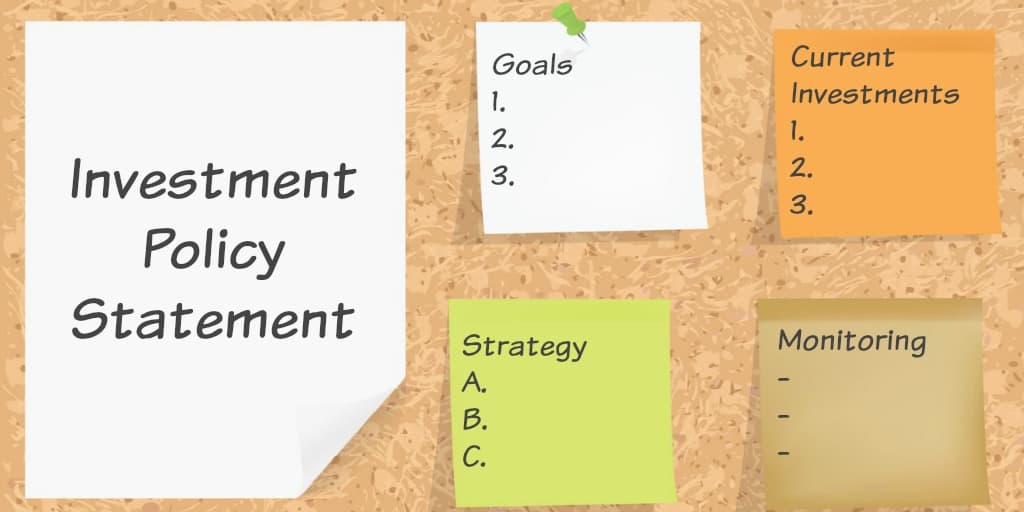Investment Policy Statement (IPS): What it is and how to write
(This page may contain affiliate links and we may earn fees from qualifying purchases at no additional cost to you. See our Disclosure for more info.)
Writing an investment policy statement (IPS) is one of the most important things you can do to build long-term wealth.
It isn’t complicated or something that only people with a ton of investments do – writing an IPS is useful for everyone.
Your IPS will help you identify and define your long-term financial goals. It encourages you to step back and take a good hard look at your savings, investments, risk tolerance, and timeline.
Better yet, it compels you to write down your goals and define your strategy to reach them.
What is an Investment Policy Statement and Why Would You Need One?
An investment policy statement (IPS) is your investing roadmap. It’s a document outlining your financial goals and strategies, with guidelines for achieving them. And it will help you stay on the right path as you move forward, despite what the market or everyone else is doing.
An IPS can be as simple or as complex as you want it to be. It provides an overall vision of your investment strategy and holdings.
You can have a single IPS or create separate ones for each investing goal you have.
If you work with a financial advisor, your IPS gives the advisor details of your objectives and preferred strategies. It also provides guidelines for communication and states your advisor’s responsibility to fiduciary rules.
How to Write an Investment Policy Statement (IPS)

Create an Investment Policy Statement customized to your needs. Below is the information you can include in your IPS.
Download our template here.
Your Investing Goals
List your financial objectives. Prioritize the timeline for each goal.
- What are your investing goals? (Retirement? College savings?)
- Which goal should take priority?
- When do you want to reach each goal? (What’s your target end date?)
Financial Advisor Duties and Responsibilities (if you have one)
If you work with a financial advisor, this section should spell out their responsibilities, including what decisions they have the authority to make.
You can also include expectations for communication and monitoring of your portfolio.
Your Current Investments
List your existing investment accounts. Include the following information for each account.
- Type of account (401k, IRA, 529, brokerage, etc.)
- Allocation
- Balance
If you own real estate investments, you can list them here, or create a separate IPS for real estate investing.
Your Investing Strategy
This section details how you will invest to reach your financial goals. It will state your preferred asset allocation and investing preferences. By nature, this section should reveal your risk tolerance.
Asset Allocation
- What is your preferred asset allocation? (For example, 70% equity/30% bonds.)
- When will you change your asset allocation? (For instance, before retirement, you might switch to a more conservative allocation.)
Preferred Investments
- What are your preferred investments? (Stock index funds? Bond funds? Dividend funds? Target date funds? Individual stocks and bonds?)
- If you like certain sub-assets classes (i.e., assets with specific characteristics), include them here – and detail their allocation. State preferences for particular investments, like small-cap or mid-cap equities, REITs, or precious metals. You can also keep it simple and leave out sub-asset classes.
Investment Selection Preferences
This section explains how you select and hold your investments. Here you will list any investment variables you want (or don’t want).
State how you decide which investments to buy and hold and which ones you avoid and sell. For example, you might prefer your funds to have specific rating levels or maximum expense ratios.
Monitoring
Here is where you state how often you (and/or your advisor) review your investments. How much you check your portfolio is up to you.
You might want an overview of your finances monthly or quarterly and take a closer look once or twice each year.
This section is also the place to state when to rebalance your assets.
What to Monitor
- Performance
- Allocation
- Costs/fees
- Ratings
- Goals and benchmarks
You won’t make changes each time you or your financial advisor does a review. But you can make a note of what to watch for at future check-ins.
Target Asset Allocation
Your asset allocation will fluctuate with time as the market changes. In this section, identify at what point you will rebalance your assets. It’s good to have a target range.
For example, let’s say you want to keep your equity holdings around 70%. You might wish to reallocate when these holdings are 5% above or below your target. So, if your allocation gets below 65% or above 75%, you will rebalance.
Procedure for Changes
Sometimes goals change and priorities shift. At some point, you might want to make changes to your portfolio. When you make changes to your goals and investments, you’ll also want to revise your Investment Policy Statement.
Criteria for Making Changes
Your IPS should help you make more informed decisions for making changes to your investments.
Set parameters for when it’s appropriate to make revisions to your plan. These parameters help establish criteria for how to evaluate changes and their consequences.
It can also keep you from making reflexive decisions you might regret later. For instance, when you see the stock market dropping, you might panic.
You could be tempted to make changes that won’t serve you well in the future. But when your IPS clearly defines your objectives, strategy, and timeline, it can help you put things into perspective.
This section also states when it’s appropriate for a financial advisor to make changes and when it’s not.
Getting Started on Writing Your IPS
If you’re creating an IPS for you or your family, start by keeping it simple. If you have a partner, talk to them about goals and strategies.
Write down your financial goals and time horizon. And then decide how to best use your investments to reach those goals.
The IPS doesn’t have to be complicated or time-consuming. You can write your investment policy statement in whatever way you want it to be – short and sweet, or longer with extensive detail.
Whatever you choose, by thinking it through and writing it down, you’ll have the roadmap you need to stay on track and reach your financial goals.

Article written by Amanda, a team member of Women Who Money and the founder and blogger behind Why We Money where she enjoys writing about happiness, values, and personal finances.
